- HOW TEMANE-MAPUTO ELECTRICITY TRANSMISSION LINE PROJECT IS GOING THROUGH TEST IN MOZAMBIQUE
- NEWLY OPENED PLASTIC RECYCLING PLANT SET TO HELP COMBAT NAMIBIA's PLASTIC INDUSTRY
- PROGRESS MADE ON PIIM PROJECTS AS OVER 85% COMPLETED IN ANGOLA
- WORLD BANK KICK-OFF INSPECTION OF USMID PROGRAM IN UGANDA
- ALGERIA MINISTER RECIEVED HARBOR ENERGY CEO OVER ENERGY PARTNERSHIP
RWANDA CONNECT ITS METHANE GAS POWER PLANT TO NATIONAL GRID

Rwanda has connected its biggest methane gas power plant to the national grid, marking a step further towards cheaper, diversified sources of energy and tapping into the gas reserve under Lake Kivu.
The methane plant was connected as the country shut down all diesel-powered plants, which were the most expensive of all current sources of energy.
Though delayed by the Covid-19 pandemic and technical issues that needed fixing before the connection to the national grid, the $400 million plant, run by Shema Power Lake Kivu (SPLK), is currently providing 37.5 megawatts.
By early 2024 the plant located on the shores of Lake Kivu in Rubavu District will be generating 56MW, according to its management.
The SPLK methane plant commissioned its first gas-to-power in March 2023, with an initial 14MW, which increased to 37.5MW, as of October.
“By February 2024, our plant will be providing a total of 56MW,” SPLK’s chief executive Alex Kabuto told The New Times.
Kabuto said that upon completion, SPLK’s plant will have the capacity to provide 68MW gross, with around 50MW injected directly into the grid.
“For the time being, and according to the contract we have with the Rwandan government, we will provide 56MW. But if the government and Rwanda Energy Group request more energy we are ready to provide 68MW,” Kabuto said.
The gas extracted from 300-400 metres underwater is washed in SPLK’s onshore tanks that separate it from water and other gases before it can be processed and connected to Rubavu Substation.
Lake Kivu has 60-70 cubic kilometres of methane of which 44.7 cubic kilometres can be extracted, according to official estimates.
Currently, there are three projects extracting methane gas for power generation from Lake Kivu. These are SPLK, KivuWatt Phase I (26MW) and Kibuye Power I (3MW).
The fourth project by Gasmeth Energy seeks to produce one million cubic metres of liquified natural gas, which is used for cooking, powering vehicles and industries.
Currently, Rwanda’s total installed capacity to generate electricity is 332.6MW from different power plants, according to Rwanda Energy Group (REG).
By generation technology mix, 51 per cent is from thermal sources, followed by hydro sources (43.9 per cent) and solar sources with around 4.2 per cent.
By tapping into Lake Kivu’s gas reserve, Rwanda reaps cheaper energy and reduces the potentially lethal methane gas explosion, which scientists say could spell the death of hundreds of thousands, if not millions, of people living near the lake in DR Congo and Rwanda.
SOURCE: NewsTime

